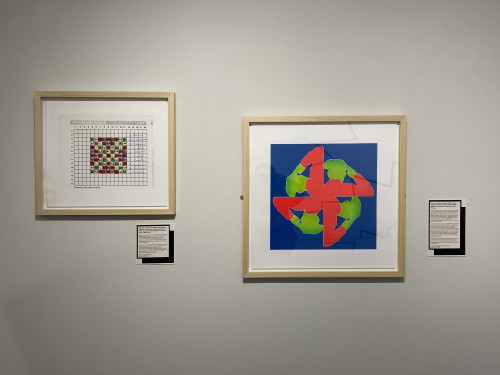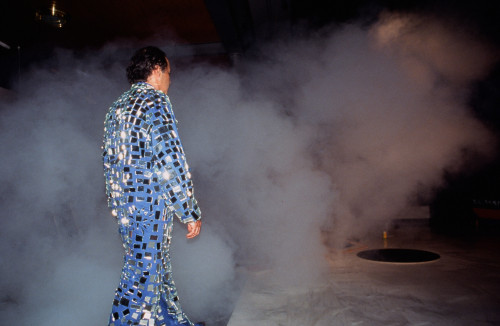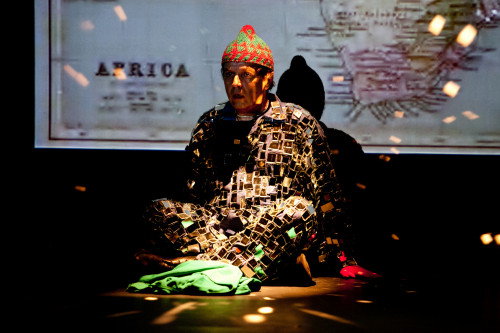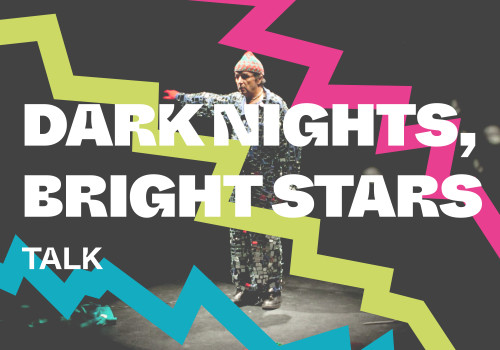Dark nights, bright stars Miguel Benlloch‘s cultural activism: the street, the club, the gallery

The darkness of the night evokes distinctive reactions in different latitudes and climates. Aberdeen in February, in the dead of winter, can be a dark, gloomy place, as the nights drag on longer than the days, bitterly cold. Yet there’s other nights, the joyous fiesta nights of Granada, where the darkness welcomes its nightly creatures in a ‘sweet chaos’ of infinite possibilities. On nights like these, darkness allows for what couldn’t be visible in the daylight’s plain sight to shine, dazzling, on.
The exhibition Dark nights, bright stars introduces Miguel Benlloch’s practice to a UK audience, charting, through a small number of artworks, his trajectory from political activist to artist-activist. Rooted in nights of clubbing and fiesta that act as places for political action and participation, Benlloch’s artistic practice unlocks new possibilities to critically address society.
Performancero, activist, writer, poet, cultural producer. The multifarious practice of Spanish artist Miguel Benlloch (Loja, Granada, 1954 – Seville, 2018) spans various fields of action, bending, twisting and questioning the boundaries between one and the other, solidly rooted in the political and social transformations happening in Spain at the time of la Transición.
During the restless, riotous yet exhilarating years of transition to a democratic system after the Francoist regime, in the late 70s, Benlloch is actively involved in various left, pacifist, anti-NATO organisations and in the Andalusian Homosexual Liberation Front. In the early 80s, he sets up Planta Baja, a nightclub that serves not only as a hub for avant garde music, but also as a ‘checkpoint’ for reimagining a new social order. In parallel to Planta Baja, Benlloch begins performing at the Communist Movement stand of the Cutre Chou, a cabaret-style variety taking place during the religious feast of Corpus Christi in Granada. The carnivalesque atmosphere of the Cutre Chou is a platform for new, irreverent forms of aesthetic expression charged with political weight, often as piercing satires.
Spain, however, moves ever more towards a capitalist, top-down societal structure, and the location of political agency shifts from grassroots movements into organised professional political structures. As exhilarating activism seems to lose its charge, Benlloch’s subversive, militant practice progressively turns towards the field of contemporary art. In 1988, together with a group of friends and collaborators, he founds BNV Producciones, a cultural organisation producing publications, events and exhibitions. His ‘proto-performances,’ carrying the transformative political charge of his activist past, and the subversive, satirical drive of the events at Planta Baja and the Cutre Chou, allow for the spaces of galleries and art centres to become active political fields, where individual agency and thought can be expressed and enacted.
The exhibition Dark nights, bright stars at The worm in Aberdeen starts with memorabilia of Planta Baja. Opened in 1983 in Granada by Benlloch, Juan Antonio Peinado and Marino Martín, the nightclub Planta Baja introduced a new creative space for both freedom and resistance, foregrounding the emergence of some of Granada’s most exciting bands, such as TNT, 091 and KGB. Not limited to underground music, Planta Baja was also active in organising exhibitions, for instance with the Augustín Parejo School, and producing fanzines, such as La Visión. Planta Baja actively participates in the counter-cultural climate that sweeps Spain after Franco’s death; in Benlloch’s words, the nightclub is ‘a spirited place [...] a borderless territory that shortened distances between its inhabitants, where everyone defended their individual personalities, producing a space of knowledge of the Other, considering us a polymorphous community inhabiting the night.’
Benlloch’s practice as performancero starts in this liminal space, on one of those fiesta nights. SIDA DA(1985) documents a performance by Benlloch and his friends, Rafa Villegas and Tomás Navarro, as Las Pekinesas. Written by Benlloch, the performance is one of many examples of his use of irreverent wordplay to denounce, criticise or parody a social problem or political event. At a time of great prejudice towards the gay community, and when society still avoids having an open conversation about the silent killer, SIDA DA plays with the language used to refer to AIDS (‘SIDA’ in Spanish), dressing it in a ‘pungent, humorous shape’ to criticise the silence that surrounds it.
Next in the display, ESTADO ROLDÁN, ESTADO LADRÓN. La Virgen del Pilar dice que no… (1994) is a video recording of Benlloch’s last performance at the Cutre Chou. Another example of wordplay used to denounce current political events, the performance takes place in the atmosphere of excess, transgression and liberation that surrounds the cabaret-style Cutre Chou (‘The Tacky Show’). Taking place within the religious feast of Corpus Christi in Granada, the Cutre expresses ‘the rupture from revolutionary certainties, and the opening up to new struggles such as feminism and sexual freedom, which placed our own lives at the heart of social change.’ Combining diverse forms of expression taken from popular culture with political messages intended as a ‘juxtaposition of images that operate as actions,’ the Cutre is as irreverent as it is politically charged, as exuberant as it is socially motivated.
A similar sharp irreverence, and the beginning of a discourse around non-normative, fluid gender identities, underpins the photograph of La braga activista (2004), here surrounded by stickers from the many political campaigns Benlloch got involved with over the years.
The loss of the NATO referendum in 1986, which sees Spain remaining in the pact, signals its now inevitable allegiance to capitalist values, as direct democracy gives way to the hierarchical structures of representational democracy. Slowly percolated through a series of encounters with people like performance artist James Lee Byars and curator Mar Villaespesa, Benlloch’s political activism is reinvigorated as artistic practice. The exhilarating, utopian possibilities glimpsed during the Transition now fuel an artistic practice that reconfigures the space of art as an opportunity for transformative political action, and challenges the role of the artist with the weight of critical freedom and political agency.
The setting up, in 1988, of BNV Producciones with childhood friend Joaquín Vázquez and collaborators Mar Villaespesa, Alicia Pinteño, and others, reiterates the collective sentiment that was behind Planta Baja and the Cutre Chou, as well as the early groups of organised political action. A sense of cooperation and organised, collective action sustains Benlloch’s transition from activism to culture. The artist is not a figure that operates in isolation and imposes their meaning and vision over a blank canvas; rather, they are a strip in a network that moves organically yet in countless diverging directions.
Dark nights, bright stars continues with some of Benlloch’s later performances, documented as videos: Acuchillad+s (2014), Desidentifícate (2010), Ibn Farum (1999), Mapuch ¡EH! (1999), and Ósmosis (1997). All these acts show Miguel Benlloch wearing a suit of mirrors and tackle current social topics such as migration, colonialism, and identity politics. The mirror-suit turning him into a kind of nightclub disco-ball, the body of the artist – and with it, metaphorically, a sense of identity – is refracted into myriads of reflections. There is no sharp divide between the artist, as an individual, and what surrounds them; the artist casts the countless facets of their experience of the world onto the space around them, which in turn is what shines light on them and ignites the play of reflections. Much like the beams of a disco-ball, the revolving flashes of light signal how reality is not a granitic structure, but ‘the trail left on the crossing of individuals.’
The final section of the exhibition is dedicated to prints. The first is a silkscreen print by Benlloch titled Algo flota (1991), whose colours pay tribute to the Spanish flag, followed by a series of new works developed by Peacock Studio in conjunction with the Miguel Benlloch Archive throughout the duration of the exhibition. These works will reimagine three photographs, drawings and designs by the artist, engaging in an active dialogue with Benlloch’s work.
From the after-dark fiestas at Planta Baja and the Cutre Chou, to the performances and actions illuminated by Benlloch’s mirror-suit, the night is omnipresent throughout the exhibition. This penumbra allows a small arts organisation such as Peacock & the worm to decentre its gaze from the hegemony of the old, Western, white male perspective, interrupting long-standing official histories while focusing on practises that embrace the fluid, the improvised and the undefined. It may be this darkness, after all, that sheds light on our new collective futures.
This exhibition has been curated in close collaboration
with Mar Villaespesa and Joaquín Vázquez (BNV Producciones).
Images, videos and artworks courtesy of the Miguel Benlloch Archive.



























